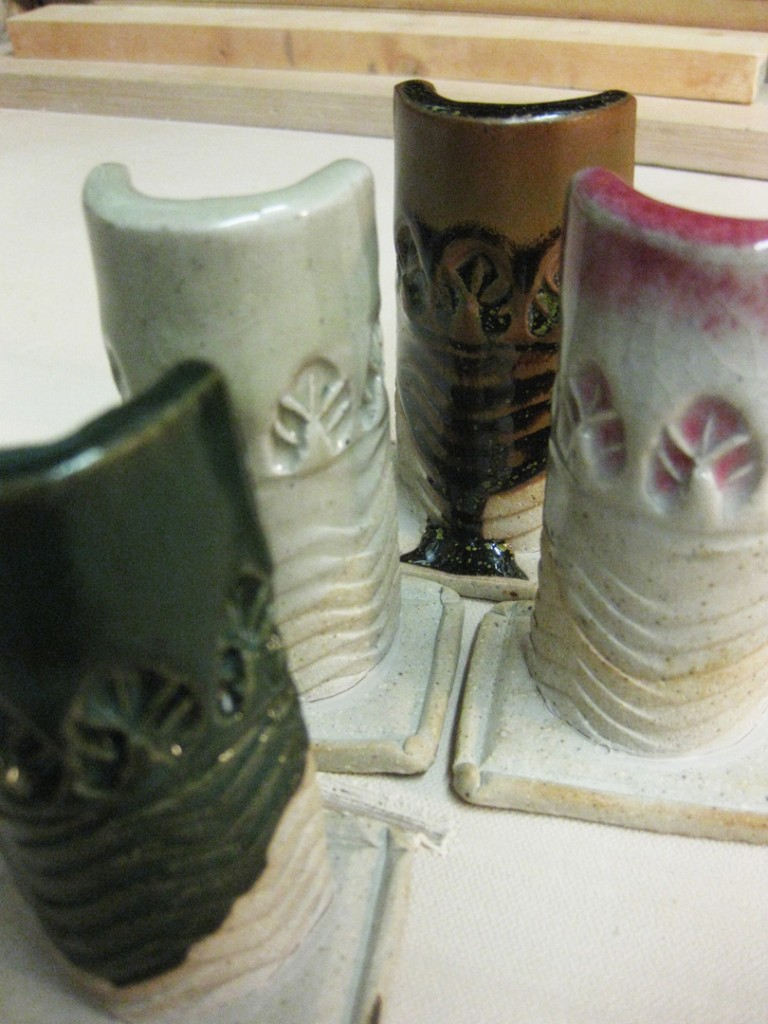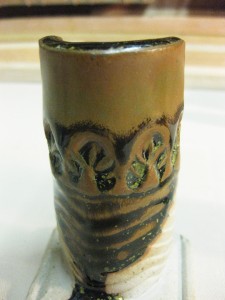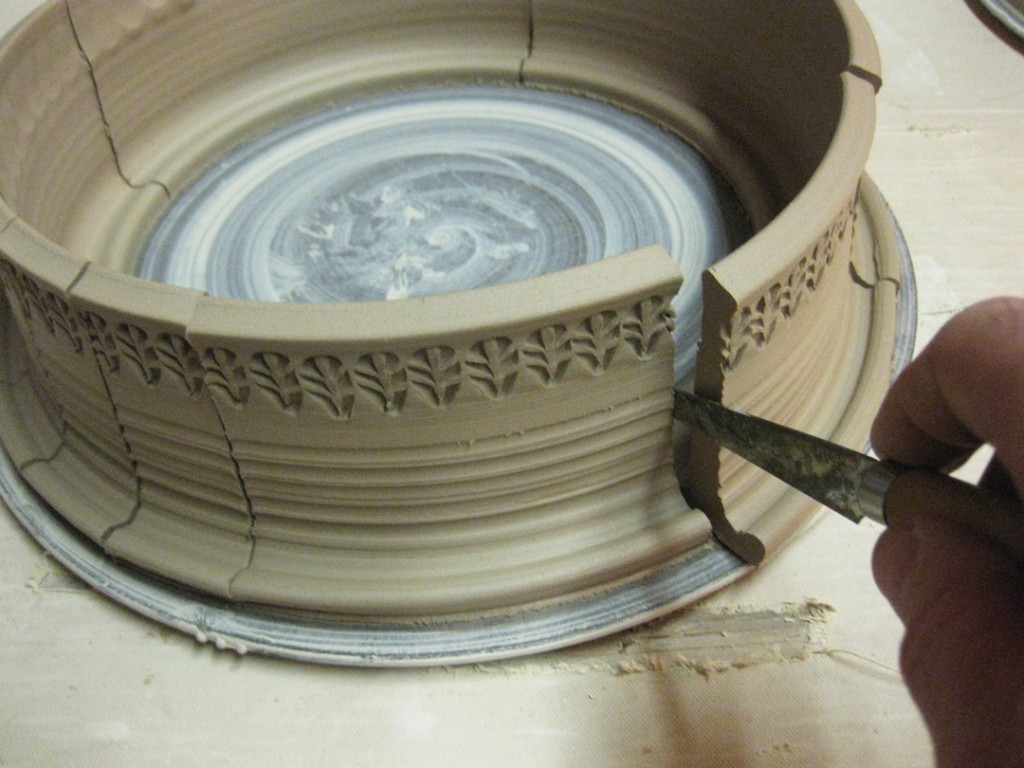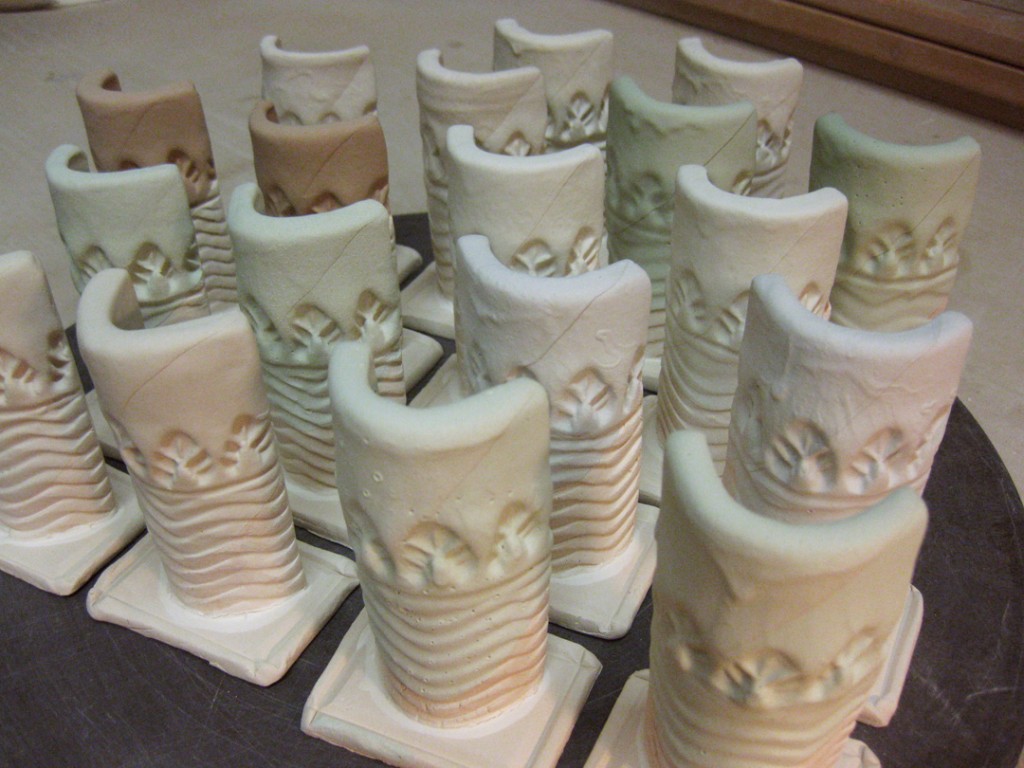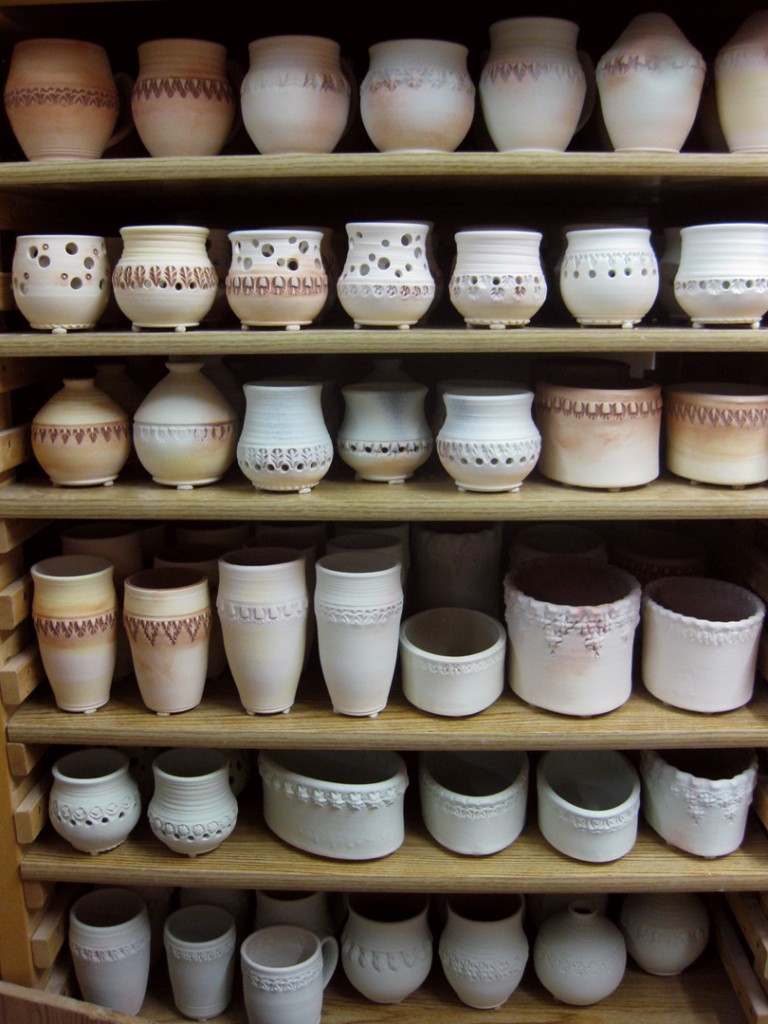So it was another round of glaze testing. I’ve been considering a little shift to do some cone 6 glazing & firing. I figure a little “pop” of color would be great. And the smaller kiln that I could fire more frequently would be a nice benefit. And if that weren’t enough, I would be even more thrilled if I could find a few good cone 6 oxidation glazes that also work in cone 10 reduction. So these are the first four samples. Cone 6 on the left, cone 10 on the right. Not sure if I’m “thrilled” with any of these yet… gotta make more!
Okay, so I’ve mixed up a few. Dipped a few.
And now the results are starting to come back from the kiln. These were the first four tests… which were designed to be cone 6 glazes, but I thought I would try them in a cone 10 kiln as well. You never know when it might work in both, right!? You can always dream…
So here’s the deal… I’m looking fro some glazes that cover well, accentuate my stamping and maybe even do some really cool breaking or color variation along the way?! So I’ve decided to try a few new glazes. And if I need to start a little cone 6 firing for an added pop of color in my inventory, then so be it.
Like I said, these are cone 6 glazes fired in a cone 10 reduction kiln. I’m pretty pleased by the results. Encouraged by these results. And hopefully that the cone 6 tests will look even better – after being fired in the kiln they were intended for! I’m hoping to get the cone 6 samples back later this week!
In the meantime, if anyone out there has some good cone 6 glaze recipes that you would be willing to share, send ’em my way! Again, I’m looking for good colors that break well on stamped textures.
Well, I’ve run out of bisqued test tiles. Yeah, the ones I made back in January, but who’s counting? Since I went through that first batch so “quickly”, I figured I needed to make another batch so I can get them bisqued and move forward!
So I started by throwing two bottomless cylinders, one in stoneware and another in soda clay. I added a bit of texture & stamping to help simulate how the glaze test might react on one of my “real” pots if I ever get that far.
Once the cylinders were leatherhard, it was time to cut them up to create some standing test tiles. I threw them with some intentional “glaze traps” at the bottoms. That way if the glaze test runs a lot it will get caught on the tile, and not run onto the kiln shelf.
As I smoothed out the edges, I also added some numbers to the fronts of them. I figure it’ll be part of my coding system, to keep track of which test tile matches up with which batch of glaze after it’s been fired.
So now they’re all lined up and drying overnight…
I spent much of tonight using a triple beam balance. It’s been so long.
And all I could think of was my high school science classes.
Chemistry class with Mr. Sparacino and my friends.
Measuring. Testing. Laughing. Good thing I retained some of that.
Or else tonight’s mini-measurements would have been a lot tougher!!!
So I just donated to Fine Mess Pottery to help in her quest to reformulate her glazes
for cone 6 soda firing. A great project with hopes of making a safer, greener & cheaper firing alternative. I love that she’s doing the work, and more than willing to share her results on her blog. So we all benefit… especially when her glaze tests work out. And as an added bonus, for my $30 donation, I’m going to receive a bound notebook of all her glaze & slip recipes!!! If you’re looking to donate a different amount, there are several other “thank you gift” levels… from thank you notes, to teabowls, to mugs, to casseroles… or even a cake stand with a cheesecake!!!
Thanks to Emily Murphy Bicking for sharing this glaze-fundraising project!
If you’d like to support her Lori Watts and her glaze reformulation project, click here.
If you want to learn more about Lori and Fine Mess Pottery, click here.
It’s always fun to go through all of your work down in the storage room. And to see everything
one more time before it goes upstairs to the Home Show. This large stamped bowl caught my
eye. Mainly because I know that the glaze is “supposed” to be a beautiful red color. Not blue.
But it’s one of those glazes that can be easily affected by the kiln firing. If there’s a little too
much oxidation in the kiln, the red glaze turns this beautiful blue-ish color.
Sadly, nothing you can ever bank on happening ever again.
Just another “happy accident” coming out of the kiln!
My bisque kiln from last night was still warmer than I would like.
So I decided to let to cool longer and dive into glazing some pieces from an earlier kiln!
I generally start by painting a lot of temoku glaze into all of the stamped impressions.
And then, once the glaze is dried, I take a moist sponge and wipe off the top surface
so that the temoku glaze stays inside the stamped impression – but not on the surface.
I love how the inlaid glaze really shows off the pattern of the stamp, instead of covering
& obliterating it with too much glaze!
But don’t think that they’re done. Oh no, I’ve got a lot of work to do on them first.
Liner glazes, sprayed accents, wadding, etc. So there’s still a lot to do… and even more
coming out of the bisque kiln tomorrow night. Not a lot of time to get everything done.
It’s my plan to load the soda kiln on Friday evening, and fire all day Saturday!




